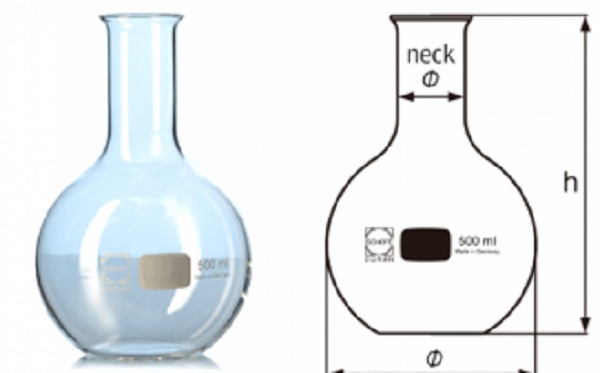What is the flat-bottomed flask for? It hints on the one hand to remember the identify the instrument, on the other how it will be the same, for which it is used, where it is used. Well, the instrument is used in laboratories for experimentation in distillation and filtration processes.
⭐What is a flat bottom flask?
It is a container whose bottom is flat, used in the laboratory, in scientific research. Its shape is above a long thin neck, below round with a flat base. It can also be described as having an elongated neck with a capacity, plus a mouth that can be covered with a stopper, with a reinforced edge. The stopper can be rubber, cork, frosted.
The capacity indicates the maximum liquid that can be filled. Attached a pear-shaped body with a flat base. Their capacity is variable because they are manufactured with different volumes 125 ml, 150 ml, 200 ml, 500 ml, 1000 ml or in liters. They are containers for samples, substances and in turn measure volumes, because they have a graduated scale.
What is the flat-bottomed flask for? they are used to perform chemical reactions on them. Its flat base allows it to stand on its own, obtaining stability on surfaces. It is said that they do not have much durability or resistance, but the manufacturers assure that it can be acquired with a thick and resistant constitution. They do not need to use a mount for them to be held.
Its vertices are contoured unlike other flasks. They can be agitated without generating spills. Manufactured to hold a certain amount of liquid. They can be made of two materials - glass and plastic.
⭐What is the function of flat bottom flask?


This glass instrument has several functions, to heat chemical compounds producing reactions and boil substances or solutions. In the cooling, preservation, mixing container. The collection, measurement of liquids, solutions, culture media. Measure volumes, weigh liquid or solid substances.
What is the flat-bottomed flask for? in the refrigeration of substances, mixing and their preservation for a period of time. Dissolve solutes in substances and transfer to another instrument. To contain precipitates and weigh it. In the formation of substances, in the crystallization of a solid. Boil substances until boiling that need long heating.
Facilitate stirring when mixing solutions. Mixing container to be distilled. Collect evaporated liquids and avoid their loss
⭐Flat bottom flask what is it made of
This laboratory utensil is made of borosilicate glass, which contains 80% silica with low expansion capacity. It belongs to the “3.3" classification of ISO 3585. The material, wall thicknesses are special for heating, chemical resistance. In Pyrex glass, which have high resistance to heat, pressure and high temperatures.
Facilitates heating, complies with ISO 1773, uniform, high mechanical, chemical and thermal shock resistance. They can also be obtained in plastic material.
⭐Types of flat bottom flask


During the history of chemistry as an experimental science they have undergone different transformations depending on the need for their use. It has been named in different ways as a volumetric flask, which measures exact volumes of certain liquid substances. By the preparation of solutions of known concentration.
The material is used for uniform heating, they have different thickness. Reagent flask, as its name says to carry out reactions, its presentation is of different thicknesses depending on the object to which it was place. Boiling, resistant to high temperatures, used to boil substances without throwing away.
⭐Flat bottom flask care
All glass parts must be checked, washed before use, free of dirty and in good condition. Do not use a flat-bottomed flask that is scratched, chipped, cracked, or has factory defects, as its strength will be seriously compromised. There would be the possibility that it breaks during use.
If you need to use a stopper for the experiment, do not put pressure on its placement during its selection. To manipulate it from one place to another take it by the base. If it merits the use of a glass stirrer, select one that does not have sharp tips because it scratches, weakens the flask. When using the flame on the flask start with a soft flame.
Adjust it gradually to avoid thermal shock (breakage). In the same way let it cool in a cool place without cold drafts. When using a heat blanket, use one that is larger than the size of the flask. Nor place the flask on the blanket once the experience is over. Do not apply the direct flame on the flask.
Use a grid to expand the heat over it. When choosing a flat-bottomed flask choose a vacuum-working one, they are thick and less likely to burst. Be sure to know the content of the theoretical and experimental part. Try that the assembly is not subjected to shocks, loud music, vibrations ensuring its stability during the experimental process.
When starting the assembly check the plug, adjust the hoses. Wear protective clothing.
The flat-bottomed flask performs the function of homogeneous distribution of heat in the substance. I invite you to consult this article as many times as you need.

